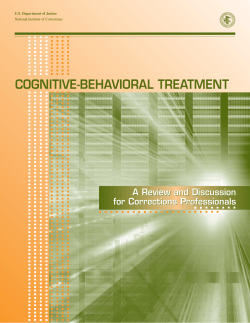
What Works with Sex Offenders?
What Works with Sex Offenders? THE INTERNATIONAL EVIDENCE Large‐scale research indicates that sex offenders who receive treatment, in both prison and community settings, have a lower sexual reconviction rate than those who do not receive treatment 1 . Cognitive‐behavioural treatment is the most effective, especially if paired with pharmacological treatment (e.g. hormonal drugs that reduce sexual drive). Other approaches (psychotherapy, counselling and non‐behavioural treatment) generally do not reduce reconviction. The most recent reviews 2 have also found that sexual offender programmes which follow the risk, need and responsivity principles 3 lead to the largest reductions in reconviction. Medium and high risk sexual offenders benefit most from treatment. Low risk sexual offenders show negligible benefits and probably do not require intensive treatment 4 . The most recent and robust review 5 , combined 26 high‐quality research studies of sex offender treatment. The sexual offending reconviction rate for treated offenders was on average 3.4 percentage points lower than that for untreated offenders (this can also be phrased as a 27% reduction in sexual offending). The general reoffending rate was also reduced by treatment. Effect of Sex Offender Treatment - Schmucker & Losel 2009 32.4 35 % recidivism 30 Treatment Group Control Group 24 25 20 12.4 15 10 9 5 0 Sexual offences All offences Mandatory treatment had as much impact as voluntary treatment. The treatment effect was better for juveniles and for high risk offenders, and was better in well‐documented programmes and May 2010 programmes that were delivered through individual sessions as well as groupwork. The impact of cognitive behavioural interventions with sexual offenders is as good as, and in some cases better than, the impact of many well‐ accepted medical and psychological treatments 6 . WHAT RISK FACTORS SHOULD TREATMENT PROGRAMMES ADDRESS? 7 Sex offending does not have a single cause, and so treatment needs to address a range of risk factors. The following risk factors should be the main targets for any treatment programme: Sexual preoccupation; sexual preference for children; preference for sex involving violence or humiliation; rare sexual interests; offence‐ supportive attitudes; seeking emotional intimacy with children rather than adults; lack of emotional intimacy with adults; impulsive lifestyle; poor problem solving; resistance to rules; generalised grievance against others; having criminal friends. The following risk factors have been less thoroughly investigated, but they probably raise risk of offending: Having hostile beliefs about women; seeing others as weak and easily manipulated; lack of concern for others; coping with problems using sexual or reckless solutions. NOMS PROGRAMMES: THE EVIDENCE o Prison Service Core SOTP The Core SOTP is the main programme for medium and high risk sex offenders in prison. In 1998, an independent research team 8 found that the Core SOTP led to improvements in nearly all of the dynamic risk factors targeted during treatment as measured by psychometric tests. Over two‐thirds of offenders changed in terms of their attitudes supporting offending, and one‐third of the sample changed in all the areas targeted by treatment. An outcome study in 2003 9 compared the 2‐year reconviction rates of 647 adult male offenders who had taken part in the Core SOTP between 1992 and 1994, with 1910 adult male offenders who had not taken part in the Core SOTP. The two samples were matched on year of discharge and shared the same broad characteristics. The treated offenders had statistically significantly lower sexual and/or violent reconviction rates at 2 years than the untreated offenders (4.6% compared to 8.1%, see graph below). The biggest impact on reconviction occurred with medium risk offenders. Low risk offenders were very unlikely to reconvict whether treated or not, and the Core SOTP did not seem to be sufficient treatment for high risk sex offenders. 9 8 7 6 5 4 3 2 Actual and Predicted 2‐Year Reconviction Rates (%) of Treated Sexual Offenders 1 0 Treated Offenders Untreated Offenders 20 10 In a survey of 46 men who attended Core SOTP , 39 out of 46 felt that doing the Core programme had been a positive, worthwhile experience. Offenders felt they improved in understanding their offences, understanding the effects on the victims, and learning how to cope differently in the future. o Prison Service Adapted SOTP NOMS has examined pre‐ to post‐treatment change on psychometric tests with a sample of over 200 offenders who had taken part in the Adapted programme 11 , a programme especially designed for sexual offender who have intellectual disabilities. There was significant pre‐ to post‐ treatment change in all of the major targets of treatment, including relapse prevention, attitudes supporting offending, denial and distortions, victim empathy and self‐esteem. o Prison Service Extended SOTP The Extended SOTP, which is delivered in addition to the Core SOTP for high risk sex offenders, has not yet been evaluated. Many of the participants who do the Extended SOTP are serving long sentences and to date not enough participants have been released to enable a proper evaluation of its impact. May 2010 Percentage Reconviction Rates Percentage Sexual and/or Violent 2‐Year Reconviction Rate Sexual and/or Violent 2‐Year Reconviction Rate (%) of Treated and Untreated Sexual Offenders o Probation Programmes The first study into probation programmes looked at 2‐year reconviction rates after treatment 12 . 133 offenders who had received treatment had a lower sexual reconviction rate than a comparison group of 191 offenders who had not received treatment. The reconviction rates of 155 sexual offenders who started C‐SOGP (one of the community sex offender programmes) have been compared with 55 offenders who did not receive treatment 13 . Those who took part in the programme had lower rates of reconviction for sexual offences than the comparison sample. Another reconviction analysis 14 found that the actual 2‐year reoffending rate of sexual offenders who completed a community sex offender programme was significantly lower than the predicted reoffending rate for this group (see below). 18 16 14 12 10 8 6 4 2 0 Actual Reconviction Rate Predicted Reconviction Rate Finally, the pre to post treatment psychometric change of a sample of 264 internet sexual offenders who took part in the i‐SOTP (treatment for internet offenders) has been examined 15 . Offenders showed an improvement in relationship skills and a decrease in pro‐offending attitudes. CONCLUSIONS AND NEXT STEPS Large‐scale reviews indicate that cognitive‐ behavioural programmes which follow the risk, need and responsivity principles are the most effective forms of intervention for sexual offenders. NOMS programmes follow these principles and although there have been too few robust reconviction studies, the evidence to date indicates that the programmes produce positive changes in areas known to be risk factors for sexual offending, and reduce sexual and/or violent reconviction. NOMS will continue to research and evaluate its interventions with sexual offenders. REFERENCES 1 Hanson, R.K., Gordon, A., Harris, A.J.R., Marques, J.K., Murphy, W., Quinsey, V.L., & Seto, M.C. (2002). First report of the collaborative outcome data project on the effectiveness of treatment for sex offenders. Sexual Abuse: A Journal of Research and Treatment, 14, 169-194; Washington State Institute for Public Policy. (2006). Evidencebased adult corrections programs: What works and what does not. Washington State Institute for Public Policy. Available online at: www.wsipp.wa.gov; Lösel, F., & Schmucker, M. (2005). The effectiveness of treatment for sexual offenders: A comprehensive meta-analysis. Journal of Experimental Criminology, 1, 117-146; Hanson, R.K., Bourgon, G., Helmus, L., & Hodgson, S. (2009). The principles of effective correctional treatment also apply to sexual offenders; A meta-analysis. Criminal Justice and Behavior, 36, 865-891. 2 Hanson, R.K., Bourgon, G., Helmus, L., & Hodgson, S. (2009). The principles of effective correctional treatment also apply to sexual offenders: A Meta-analysis. Criminal Justice and Behavior, 36, 865-891. 3 Andrews, D.A., & Bonta, J. (2003). The psychology of criminal conduct. Third edition. Cincinnati, OH: Anderson. 4 Mailloux, D.L., Abracen, J., Serin, R., Cousineau, C., Malcolm, B., & Looman, E.J. (2003). Dosage of treatment to sexual offender: Are we overprescribing? International Journal of Offender Therapy and Comparative Criminology, 47, 171-184; Lovins, B., Lowenkamp, C.T., & Latessa, E.J. (2009). Applying the risk principle to sex offenders. Can treatment make some sex offenders worse? The Prison Journal, 89, 344-357; Friendship, C., Mann, R.E., & Beech, A.R. (2003). Evaluation of a National Prison-based Treatment Program for Sexual Offenders in England and Wales. Journal of Interpersonal Violence, 18, 744-759. 5 Schmucker, M & Losel, F. (2009). A systematic review of high quality evaluations of sex offender treatment. Paper presented at the Annual Conference of the European Society of Criminology, Ljubljana, Slovenia. 6 Marshall, W. L. & McGuire, J. (2003). Effect sizes in the treatment of sex offenders. Int. J. of Offender Therapy and Comparative Criminology, 47, 653-663 7 Mann, R.E., Hanson, R.K., & Thornton, D. (2010). Assessing risk for sexual offending: Some proposals on the nature of meaningful risk factors. In press in Sexual Abuse: A Journal of Research and Treatment. 8 Beech, A., Fisher, D., & Beckett, R. (1998). An evaluation of the Prison Sex Offender Treatment Programme. A report for the Home Office by the STEP Team. 9 Friendship, C., Mann, R.E., & Beech, A.R. (2003). Evaluation of a National Prison-based Treatment Program for Sexual Offenders in England and Wales. Journal of Interpersonal Violence, 18, 744-759. 10 Wakeling, H.C., Webster, S.D., & Mann, R.E. (2005). Sexual offenders’ treatment experience: A qualitative and quantitative investigation. Journal of Sexual Aggression, 11, 171-186. 11 Williams, F., Wakeling, H., & Webster, S. (2007). A psychometric study of six self-report measures for use with sexual offenders with cognitive and social functioning deficits. Psychology, Crime and Law, 13, 505-522. 12 Hedderman, C., & Sugg, D. (1996). Does treating sex offenders reduce re-offending? Home Office Research Study, no. 45. London: Home Office. 13 Allam, J. (1998). Effective practice in work with sex offenders: A reconviction study comparing treated and untreated offenders. West Midlands: West Midlands Probation Service Sex Offender Unit. 14 Hollis, V. (2007). Reconviction Analysis of Programme Data using Interim Accredited Programmes Software (IAPS). Unpublished report, Ministry of Justice. 15 Middleton, D., Mandeville-Norden, R., & Hayes, E. (2009). Does treatment work with Internet sex offenders? Emerging findings from the internet sex offender treatment programme (i-SOTP). Journal of Sexual Aggression, 15, 5-19. May 2010
© Copyright 2025


















